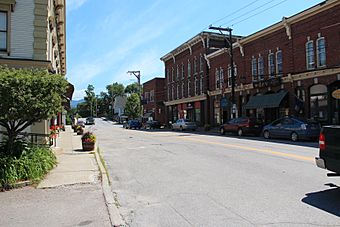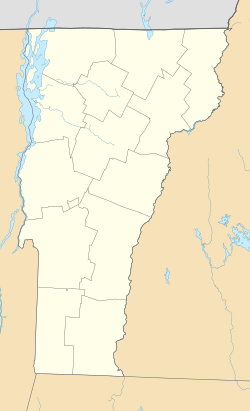Waterbury Village Historic District facts for kids
Quick facts for kids |
|
|
Waterbury Village Historic District
|
|
 |
|
| Location | U.S. 2, Waterbury, Vermont |
|---|---|
| Area | 102 acres (41 ha) |
| Architectural style | Greek Revival, Federal, Late Victorian |
| NRHP reference No. | 78000249 |
| Added to NRHP | August 24, 1978 |
The Waterbury Village Historic District is a special area in Waterbury, Vermont. It includes most of the main shops and homes in the center of the village. This historic district is found along U.S. Route 2 and Stowe Street. It stretches south from the Thatcher Branch of the Winooski River. Over the years, changes in how people traveled and important new businesses helped shape this area. One big change was the start of the Vermont State Hospital. This hospital is at the southern end of the village. In 1978, the district was added to the National Register of Historic Places. This means it's recognized as an important historical site.
Contents
Waterbury Village: A Historic Place
The Waterbury Village Historic District is like a living museum. It shows how a Vermont town grew and changed over time. It covers about 102 acres. This area has many buildings from different time periods. You can see styles like Greek Revival and Victorian.
How Waterbury Grew
Waterbury's story began a long time ago. Its growth was shaped by how people moved around and what jobs they had.
Early Days and Stagecoaches
Waterbury was first settled around 1770. A few houses were built near the Winooski River. This was close to where Winooski Street is today. In the 1790s, Main Street opened. This was an important road for stagecoaches. Stagecoaches were like early buses. They carried people and goods. Because of this new road, more buildings appeared on Main Street. Churches, homes, and shops were built there. Development also started on Stowe Street. This street runs north from Main Street. It follows the eastern side of the Thatcher Branch river. The Thatcher Branch was also good for factories. Its water powered early industries. These factories helped the town grow even more.
The Railroad Arrives
A big change came in 1849. The railroad was built through Waterbury. The main train station was located south of the main business area. This led to new shops and businesses opening near the station. Factories also grew along the railroad tracks. This made it easier to transport goods.
A Growing Community
In 1892, the Vermont State Hospital opened. This was a very large building. It brought more people and jobs to Waterbury. This led to more growth south of the train station. Randall Street was developed during this time. It runs next to Main Street. Randall Street became a pretty area with many trees and homes.
Exploring the District Today
The main part of the historic district is Main Street (US 2). It goes from the Thatcher Branch crossing south past the Vermont State Hospital. Today, the hospital buildings are mostly state offices. The railroad tracks run next to Main Street. The district also includes Railroad Street and Union Street. These streets are on the other side of the tracks. Other connecting streets are Park Row, where the old train station is. Stowe Street has the busiest part of the business district. This is where it meets Main Street. The district also goes about halfway down Winooski Street to the Winooski River. It also includes Randall Street between Elm Street and the old hospital buildings.



